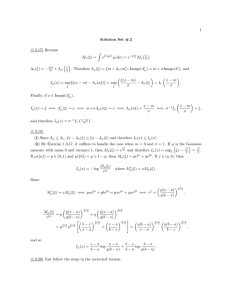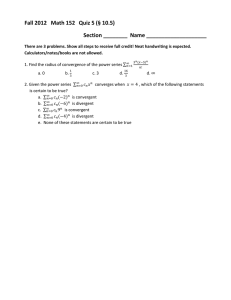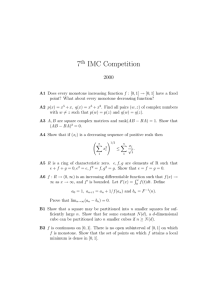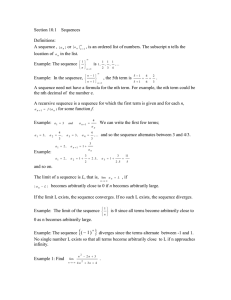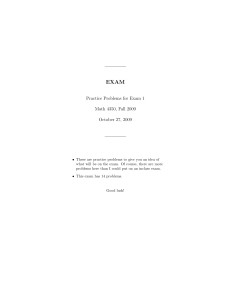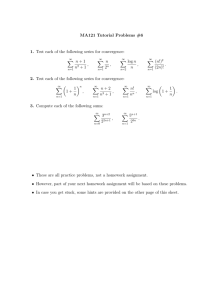Document 10677530
advertisement
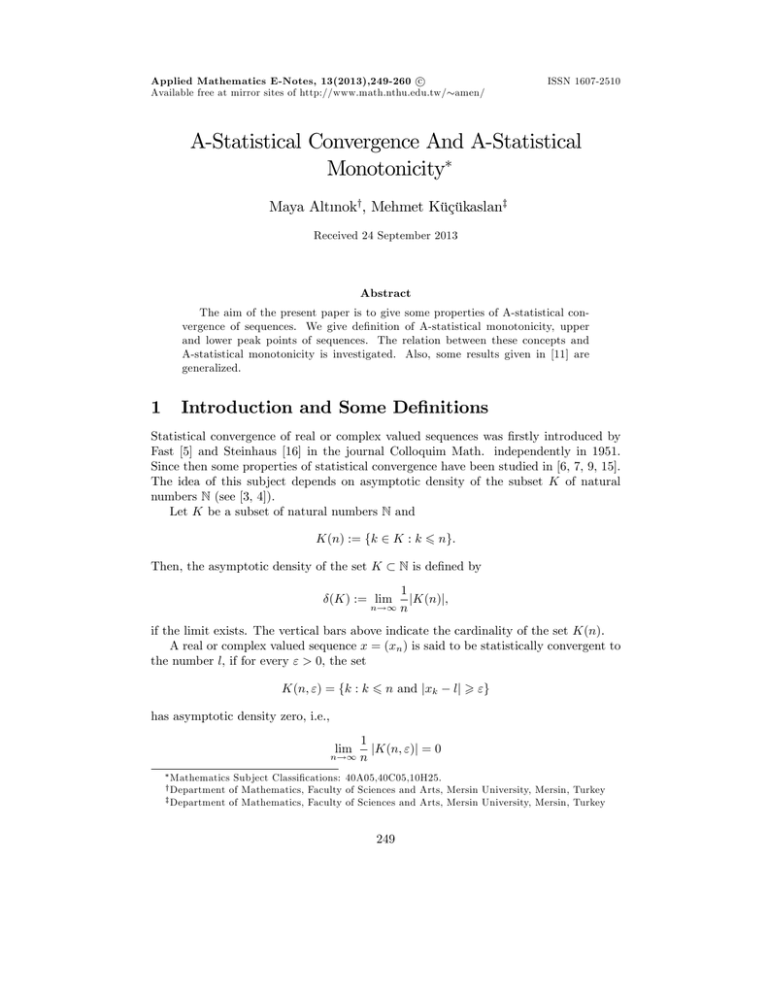
Applied Mathematics E-Notes, 13(2013),249-260 c Available free at mirror sites of http://www.math.nthu.edu.tw/ amen/ ISSN 1607-2510 A-Statistical Convergence And A-Statistical Monotonicity Maya Alt¬noky, Mehmet Küçükaslanz Received 24 September 2013 Abstract The aim of the present paper is to give some properties of A-statistical convergence of sequences. We give de…nition of A-statistical monotonicity, upper and lower peak points of sequences. The relation between these concepts and A-statistical monotonicity is investigated. Also, some results given in [11] are generalized. 1 Introduction and Some De…nitions Statistical convergence of real or complex valued sequences was …rstly introduced by Fast [5] and Steinhaus [16] in the journal Colloquim Math. independently in 1951. Since then some properties of statistical convergence have been studied in [6, 7, 9, 15]. The idea of this subject depends on asymptotic density of the subset K of natural numbers N (see [3, 4]). Let K be a subset of natural numbers N and K(n) := fk 2 K : k 6 ng: Then, the asymptotic density of the set K (K) := lim n!1 N is de…ned by 1 jK(n)j; n if the limit exists. The vertical bars above indicate the cardinality of the set K(n). A real or complex valued sequence x = (xn ) is said to be statistically convergent to the number l, if for every " > 0, the set K(n; ") = fk : k 6 n and jxk lj > "g has asymptotic density zero, i.e., lim n!1 1 jK(n; ")j = 0 n Mathematics Subject Classi…cations: 40A05,40C05,10H25. of Mathematics, Faculty of Sciences and Arts, Mersin University, Mersin, Turkey z Department of Mathematics, Faculty of Sciences and Arts, Mersin University, Mersin, Turkey y Department 249 250 A-statistical Convergence and A-Statistical Monotonicity and it is denoted by xn ! l(S) or st limn!1 xn = l. Statistically convergence is deeply connected to the strongly Cesàro summability and uniform summability (see [10]). Let A = (ank ) be a matrix. If the matrix A = (ank ) transforms convergent sequences to convergent sequences with the same limit, then it is called regular. The following theorem gives the conditions for a matrix to be regular: THEOREM 1.1. ([18], p.165) A = (ank ) is a regular matrix if and only if the following conditions hold P (i) supn jank j < 1; (ii) ank ! 0 (n ! 1; k …xed); and P (iii) ank ! 1 (n ! 1): A-density of a subset K of the natural numbers N is de…ned as X ank ; A (K) := lim n!1 k2K if the limit exists. The sequence x = (xn ) is A-statistically convergent to l 2 R, if for every " > 0, the set K(n; ") := fk : k 6 n; jxk lj > "g has A-density zero [8]. It is denoted by xn ! l(A st). 2 Some Results About A-Statistical Convergence The space of all complex valued sequences x = (xn ) will be denoted by CN . In many circumstances we refer to CN as the space of arithmetical functions f : N ! C, specially, when f re‡ects the multiplicative structure of N. This is the case for additive and multiplicative functions. Throughout this article, the matrix A = (ank ) is non-negative and regular. De…ne the function dA : CN CN ! [0; 1) as follows, X dA (x; y) := lim sup ank '(jxk yk j) n!1 k6n for x = (xn ), y = (yn ) 2 CN and ' is the function ' : [0; 1) ! [0; 1) where '(t) := t 1 if t 6 1; if t > 1: It is clear that, the function dA is a semi-metric and it is called A-semi-metric on CN . THEOREM 2.1. The sequence x = (xn ) is A-statistically convergent to l 2 R if and only if dA (x; y) = 0 where yn = l for all n 2 N. M. Alt¬nok, M. Küçükaslan 251 PROOF. Let us assume dA (x; y) = 0 where yn = l for all n 2 N. Then, if " > 0, 8 P < 1" lim sup k6n ank '(jxk lj); " jxk lj 1; X n!1P lim sup ank jxk lj > 1; : lim sup k6n ank '(jxk lj); n!1 k6n jxk lj>" n!1 6 max 1; 1 " X lim sup n!1 ank '(jxk 1 " lj) = max 1; k6n dA (x; l): This calculation implies that xn ! l(A st). Now, assume that x = (xn ) is A-statistically convergent to l 2 R. Then for every " > 0, X X X ank '(jxk yk j) = ank '(jxk lj) + ank '(jxk lj) k6n k6n jxk lj<" 6 " X k6n k6n jxk lj>" X ank + ank : k6n jxk lj>" Then, since A = (ank ) is a regular matrix, we have X X dA (x; y) = lim sup ank '(jxk yk j) 6 " lim sup ank + lim sup n!1 n!1 k6n and this implies that n!1 k6n X ank 6 " k6n jxk lj>" dA (x; y) 6 " for any " > 0 where y = (yn ) and yn = l (n 2 N). This ends the proof. COROLLARY 2.1. If the sequence x = (xk ) is convergent to l (in the usual case) then dA (x; y) = 0, where yn = l for all n 2 N. PROOF. Let us assume x = (xk ) is convergent to l, i.e., for each " > 0, there exists at least an n0 = n0 (") 2 N such that jxn lj < 2" holds for all n > n0 . Therefore, since A is a regular matrix X dA (x; y) = lim sup ank '(jxk lj) n!1 = k6n 2 lim sup 4 n!1 6 lim sup n!1 X ank '(jxk lj) + k6n0 X k6n0 ank '(jxk n0 +16k6n ank + lim sup n!1 6 n0 lim sup ank + " lim sup n!1 X n!1 n X k=n0 +1 n X ank jxk ank < k=n0 +1 lj " " + = ": 2 2 3 lj)5 252 A-statistical Convergence and A-Statistical Monotonicity REMARK 2.1. The converse of Corollary 2.1 is not true in general. To see this, let us consider the sequence x = (xn ) where p n for n = m2 and m = 1; 2; :::; xn = 0 otherwise; and the regular matrix A = C1 , the Cesàro matrix. It is clear that dA (x; 0) = lim sup n!1 1X '(jxk n n 0j) = lim sup n!1 k6n 1 Xp k = 0: n k=1 But the sequence above is not convergent to 0 in the usual case. Let f be an arithmetical function. With MA (f ), we denote A-value of f , X MA (f ) := lim ank f (k) n!1 k6n if the limit exists. THEOREM 2.2. Assume that f : N ! C is bounded and A-statistically convergent to L and H N is an arbitrary subset of N which has …nite A-density A (H). Then, MA (1H f ) = L A (H). PROOF. From the following inequality the proof can be obtained easily: X ank f (k) k2H 6 " X k2H 3 X ank L 6 k2H ank + X k2H jf (k) Lj " X k2H jf (k) Lj<" ank jf (k) ank jf (k) Lj < " A (H) Lj + X k2H jf (k) Lj " + " < "( A (H) ank jf (k) Lj + 1) < ": A-Statistical Monotone Sequence Statistical monotonicity for real valued sequences has been de…ned and studied in [11] In this section, A-statistical monotonicity will be de…ned and its relation between A-statistical convergence will be investigated. DEFINITION 3.1. A sequence x = (xn ) is called A-statistical monotone increasing (decreasing), if there exists a subset H of the natural numbers N with A (H) = 1 such that the sequence x = (xn ) is monotone increasing (decreasing) on H. A sequence x = (xn ) is called A-statistical monotone sequence if it is A-statistical monotone increasing or A-statistical monotone decreasing. Now, we list some results about A-statistical monotonicity: PROPOSITION 3.1. If x = (xn ) is monotone sequence then x = (xn ) is A-statistical monotone. The converse is not true. M. Alt¬nok, M. Küçükaslan 253 PROOF. Assume x = (xn ) is a nondecreasing sequence. That is, for all n 2 N, xn xn+1 . So, we can consider the set H = N. Since, A (H) = 1, we see that x = (xn ) is A-statistical monotone increasing. The proof can be obtained by the same way when the sequence is monotone decreasing. Let us consider the sequence x = (xn ) as xn = 1 for n = m2 and m = 1; 2; :::; n otherwise, and the matrix A = C1 . It is clear that x = (xn ) is A-statistical monotone increasing but it is not monotone increasing. THEOREM 3.1. If the sequence x = (xn ) is A-statistical monotone increasing or A-statistical monotone decreasing, then the set fk 2 N : xk+1 < xk g or fk 2 N : xk+1 > xk g has A-density zero respectively. PROOF. Let us assume that x = (xn ) is A-statistical monotone increasing. That is, there exist a subset H of N with A (H) = 1 such that (xn ) is monotone increasing on H, i.e., xn 6 xn+1 for all n 2 H: Therefore, the inclusion fk 2 N : xk+1 < xk g N 2 N : xk+1 < xk g) 6 A (N H and the inequality A (fk H) = 0 hold. From this argument the assertion is satis…ed. REMARK 3.1. The converse of Theorem 3.1 is not true in general. This can be seen by looking at the example given in (page 264, [11]). THEOREM 3.2. Let x = (xn ) be a sequence. If x = (xn ) bounded and A-statistical monotone, then x = (xn ) is A-statistical convergent. PROOF. We shall give the proof only for A-statistical monotone increasing sequence. From the de…nition of A-statistical monotonicity of x = (xn ), there exists a subset H of N such that A (H) = 1 and x = (xn )n2H is monotone increasing. Let us denote the element of H by kn . Without lost of generality, we may assume that kn is a monotone increasing sequence of natural numbers. Then (xkn ) is the monotone increasing subsequence of (xn ). 254 A-statistical Convergence and A-Statistical Monotonicity Since the sequence x = (xn ) is bounded, we see that the subsequence (xkn ) is also bounded. Therefore, the subsequence (xkn ) is convergent to sup xkn . It means that, for every " > 0 there exists a positive natural number kn0 = kn0 (") 2 N such that jxkn sup xkn j < " holds for all kn > kn0 . Since all convergent sequence is A-statistical convergent, we see that xkn ! sup xkn (A st) and K(n) : = = = fk 6 n : jxk sup xk j > "g fk 6 n : k 6= kn and jxk [ fk 6 n : k = kn and jxk sup xk j > "g K 1 (n) [ K 2 (n): sup xk j > "g Since K 1 (n) N H and xkn ! l(A st), we see that (K 1 (n)) = 0 and (K 2 (n)) = 0 respectively. Therefore, xn ! l(A st). REMARK 3.2. Boundedness of A-statistical monotone sequence is su¢ cient but not necessary for A-statistical convergence in general. To see this let us consider the matrix A = C1 and sequence x = (xn ) where xn = m 1 n for n = m2 and n 2 N, for n = 6 m2 : It is easy to see that the sequence x = (xn ) is not bounded but it is statistical monotone decreasing and statistically convergent to zero. REMARK 3.3. For a bounded sequence, A-statistical monotonicity is su¢ cient but not necessary for A-statistical convergence. Let us consider the matrix A = C1 and the sequence x = (xn ) de…ned by xn := 1 n 1 n for n is odd, for n is even. It is clear that x = (xn ) is bounded and statistical convergent to zero but it is not statistical monotone. DEFINITION 3.2. The real number sequence x = (xn ) is said to be A-statistical bounded if there is a number M > 0 such that A (fn 2 N : jxn j > M g) = 0: REMARK 3.4. For A-statistical convergence, boundedness and A-statistical monotonicity is su¢ cient but not necessary. M. Alt¬nok, M. Küçükaslan 255 Let us consider the Cesàro matrix and the sequence x = (xn ) de…ned by 8 n for n is an odd square, > > < 2 for n is an even square, xn = 1 for n is an odd nonsquare, > > : n1 for n is an even nonsquare. n (1) Obviously, x = (xn ) is statistical convergent to zero but the sequence is neither Astatistical bounded nor statistical monotone. By using De…nition 3.2, we may give the weak converse of Theorem 3.2 without proof as follows: THEOREM 3.3. A-statistical monotone sequence x = (xn ) is A-statistical convergent if and only if x = (xn ) is A-statistical bounded. 4 Peak Points and A-Statistical Monotonicity In [11] the concept of peak points of real valued sequences has been de…ned and its relation between statistical monotonicity and statistical convergence has been investigated. Let us recall the de…nitions of upper and lower peak points: DEFINITION 4.1.([11]). The element xk is called an upper (or lower) peak point of the sequence x = (xn ) if xk > xl (respectively xl > xk ) holds for all l > k. The element xk is called a peak point of the sequence if it is an upper peak point or lower peak point. THEOREM 4.1. If the index set of peak points of the sequence x = (xn ) has A-density 1, then the sequence x = (xn ) is A-statistical monotone. PROOF. Let us denote the index set of upper peak points of the sequence x = (xn ), H := fk : xk is an upper peak point of (xn )g: There exist a monotone increasing sequence (kn ) of positive natural number such that the set H can be represented as H := fk1 < k2 < k3 < :::g with A (H) = 1. Since, xkn is an upper peak point for all n 2 N, the following xk1 > xk2 > xk3 > ::: > xkn > ::: inequalities hold. So, xn is A-statistical monotone decreasing. By using the same arguments for lower peak points the proof is obtained easily. 256 A-statistical Convergence and A-Statistical Monotonicity Let nk be a strictly increasing sequence of positive natural numbers and x = (xn ) be a real valued sequence. De…ne x ~ = (xnk ) and Kx~ = fnk : k 2 Ng. DEFINITION 4.2. The subsequence x ~ = (xnk ) of x = (xn ) is called (I) A-dense subsequence if A (Kx~ ) = 1, (II) A-empty subsequence if A (Kx~ ) = 0. DEFINITION 4.3. The sequences x = (xn ) and y = (yn ) are called A-statistical equivalent if there exists a subset M of N with A (M ) = 1 such that xn = yn for all n 2 M . A-statistical equivalence is denoted by x (A) y. In the following we list some properties of A-statistical monotonicity and peak points: (I) Every A-dense subsequence of an A-statistical monotone sequence is A-statistical monotone. (A) (II) Let x = (xn ) and y = (yn ) be A-statistical equivalent sequences, i.e. x y. Then, x = (xn ) is A-statistical monotone if and only if y = (yn ) is A-statistical monotone. (III) If the sequence x = (xn ) is A-statistical monotone, then it has at least an A-dense and an A-empty subsequence. The converse is not true. Let us consider the Cesàro matrix and the sequence x = (xn ) given in (1). The subsequence (yn ) = = (x2 ; x3 ; x4 ; x5 ; x6 ; x7 ; x8 ; x10 ; x11 ; x12 ; x13 ; x14 ; x15 ; x16 ; ::) 1 1 1 1 1 1 1 1 1 1 1 1 ; ; 2; ; ; ; ; ; ; ; ; ; ; 2; ::: 2 3 5 6 7 8 10 11 12 13 14 15 and (zn ) = (x1 ; x9 ; x25 ; x49 ; x81 ; :::) = (1; 9; 25; 49; 81; :::) are C1 -dense and C1 -empty subsequence of x = (xn ). But it is not statistical monotone. (IV) If the index set of peak points of the sequence has A-density 1, then it has monotone A-dense and A-empty subsequences. THEOREM 4.2. Under the condition of Theorem 4.1, if the sequence xn is Astatistical bounded then it is A-statistical convergent. PROOF. From the assumption of Theorem 4.1, we can assume x = (xn ) is Astatistical monotone increasing and A-statistical bounded. Therefore, the proof is obtained by using Theorem 3.3. 5 Inclusion Results for C and D Let = (n) be a strictly increasing sequence of positive natural numbers such that (0) = 0. C and D asymptotic density of a subset of K of natural numbers N is M. Alt¬nok, M. Küçükaslan 257 de…ned by 1 jfk 2 K : k 6 (n)gj (n) lim n!1 and lim n!1 1 (n) (n 1) jfk 2 K : (n 1) < k 6 (n)gj respectively. The more detailed knowledge about the densities C and D can be found in [2], [14, 17] respectively. THEOREM 5.1. If the sequence x = (xn ) is D -statistical monotone, then it is C -statistical monotone. PROOF. We shall apply the technique which was used by Agnew in his paper [1]. Assume, x = (xn ) is a D -statistical monotone. That is, there is a subset H of N such that D (H) = 1, and (xn ) is monotone on H. Let us denote the set fk : k 6 (n); k 2 Hg by H(n). The set H(n) can be represented as H(n) = = fk 2 H : (0) + 1 6 k 6 (1)g [ fk 2 H : (1) + 1 6 k 6 (2)g [ ::: [ fk 2 H : (n 1) + 1 6 k 6 (n)g n [ fk 2 H : (j 1) + 1 k (j)g; j=1 for an arbitrary n 2 N. From this representation we have jH(n)j = = jfk 2 H : 1 6 k 6 (1)gj + jfk 2 H : (1) + 1 6 k 6 (2)gj + ::: + jfk 2 H : (n 1) + 1 6 k 6 (n)gj n X jfk 2 H : (j 1) + 1 6 k 6 (j)gj j=1 and n X (j) 1 jH(n)j = (n) j=1 (j (n) 1) 1 (j) (j 1) jfk 2 H : (j Let us consider the matrix T = (tn;k ) de…ned by ( (k) (k 1) for k = 1; 2; :::; n; (n) tn;k := 0 otherwise. Clearly, the matrix T is regular, and C (H) = T D (H): 1) + 1 6 k 6 (j)gj : 258 A-statistical Convergence and A-Statistical Monotonicity Since, limn!1 ( D (H))n = 1 and T is regular, C (H) = 1: It means that the sequence x = (xn ) is D -statistically monotone. THEOREM 5.2. Let E = f (n)g be an in…nite subset of N with (0) = 0. Then, a C -statistical monotone sequence is also D -statistical monotone sequence if and only if (n) lim inf > 1: n!1 (n 1) PROOF. Let x be a C -statistical monotone sequence. That is, there exists a subset H of N such that C (H) = 1 and (xn ) is monotone on H. From the de…nition of D (H) we have jfk 2 N : (n 1) + 1 6 k 6 (n)gj (n) (n 1) jfk 2 H : 1 6 k 6 (n)gj (n) (n) (n 1) (n) (n 1) jfk 2 H : 1 6 k 6 (n 1)gj : (n) (n 1) (n 1) lim n!1 = If we let the matrix T = (tn;k ) de…ned by 8 (n) > < (n) (n 1) (n 1) tn;k = (n) (n 1) > : 0 for k = n; for k = n 1; otherwise, we obtain ( D (H))n = (T ( C (H)))n . Therefore, D (H) is obtained by C (H) if and only if T is regular. Thus, T will be regular if and only if the sequence (n) (n) (n 1) + (n (n) 1) (n 1) (2) n2N is bounded. After simple calculation (2) is bounded if and only if lim inf n!1 1. (n) (n 1) > The following corollaries are simple consequences of Theorem 6.2 in (page 208, [11]). COROLLARY 5.1. E = f (n)g and F = f (n)g be an in…nite subset of N. If F E is …nite, then C -statistical (D -st.) monotonicity implies C -statistical (D st.) monotonicity. COROLLARY 5.2. Assume F E is …nite. Then C (D ) statistical monotonicity implies if C (respectively D ) statistical monotonicity and vice versa. M. Alt¬nok, M. Küçükaslan 259 COROLLARY 5.3. Let E = f (n)g be an in…nite subset of N and lim sup n!1 (n + 1) = 1: (n) Then, the sequence x = (xn ) is C -statistical monotone if and only if it is statistical monotone. References [1] R. P. Agnew, On deferred Cesàro mean, Ann. of Math., 33(1932), 413–421. [2] D. H. Armitage and I. J. Maddox, A new type of Cesàro mean, Analysis, 9(1989) 195–204. [3] R. C. Buck, The measure theoretic approach to density, Amer. J. Math., 68(1946), 560–580. [4] R. C. Buck, Generalized asymptotic density, Amer. J. Math., 75(1953), 335–346. [5] H. Fast, Sur la convergence statistique, Colloq. Math., 2(1951), 241–244. [6] J. A. Fridy, On statistical convergence, Analysis, (1985), 301–313. [7] J. A. Fridy, Statistical limit points, Proceeding of the American Mathematical Society, 4(1993), 1187–1192. [8] J. A. Fridy and H. I. Miller, A matrix characterization of statistical convergence, Analysis, 11(1991), 59–66. [9] J. A. Fridy and C. Orhan, Statistical limit superior and statistical limit inferior, Proc. of American Math. Soc., 12(1997), 3625–3631. [10] K. H. Indlekofer, Cesàro means of additive functions, Analysis, 6(1996), 1–24. [11] E. Kaya, M. Küçükaslan and R. Wagner, On statistical convergence and statistical monotonicity, Annales Univ. Sci. Budapest. Sect. Comp., 39(2013), 257–270. [12] P. Kostyrko, M. Macaj, T. Salat and O. Strouch, On statistical limit points, Proc. Amer. Math. Soc., 9(2000), 2647–2654. [13] L. Kupers and M. Niederreiter, Uniform Distribution of Sequences, Wiley, New York, 1974. [14] J. A. Osikiewicz, Summability of Matrix Submethods and Spliced Sequences, PH.D. Thesis, August 90 pp. (1997) which University, Kent State University. [15] T. Salat, On statistically convergent sequences of real numbers, Math. Slovaca, 2(1980), 139–150. 260 A-statistical Convergence and A-Statistical Monotonicity [16] H. Steinhaus, Sur la convergence ordinaine et la convergence asymptotique, Colloq. Math., 2(1951), 73–74. [17] M. Y¬lmaztürk and M. Küçükaslan, On strongly deferred Cesàro summability and deferred statistical convergence of the sequences, Bitlis Eren Univ. J. Sci. and Technology, 3(2013), 22–25. [18] I. J. Maddox, Elements of Functional Analysis, Cambridge Univ. Press, 1970.

